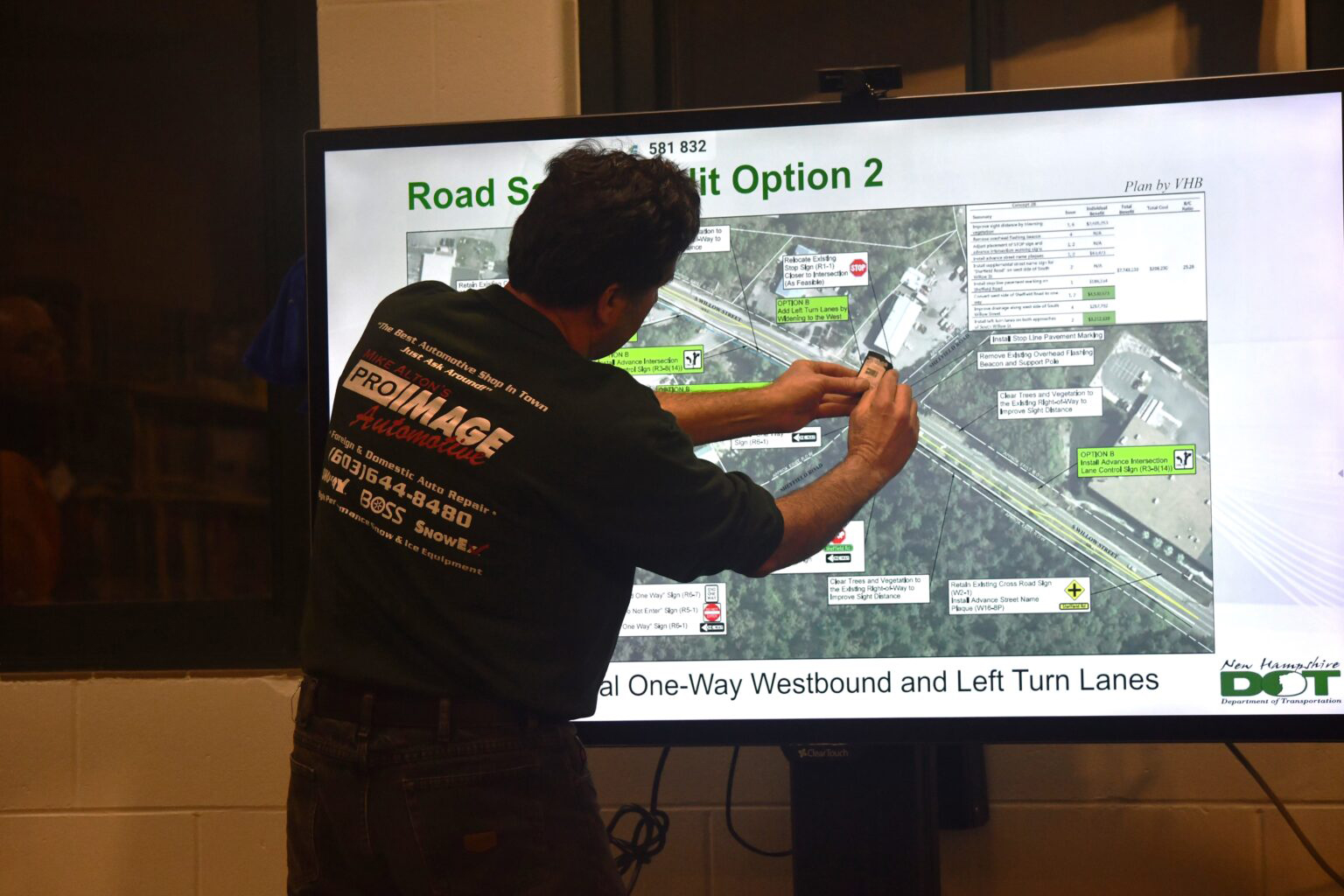
Business owner Mike Alton describes how cars fall into his parking lot. (Photo by Andrew Sylvia) Representatives from the New Hampshire Department of Transportation (NHDOT), the engineering firm Fuss and O’Neil and the Manchester Department of Public Works were on hand to take questions at McLaughlin Middle School on Thursday night as the state begins the process to address one of the city’s most dangerous intersections.
The NHDOT project discussed at the informational meeting, known as Manchester 43960, aims to renovate the intersection of Sheffield Road and South Willow Street/NH Route 28 due to a significant number of car crashes.
Although the Manchester Board of Mayor and Aldermen approved making the portion of Sheffield Road to the west of South Willow Street go one way heading away from South Willow Street beginning this spring, planning was already in place for NHDOT to pursue additional safety measures on South Willow Street, which is maintained by the state in that area.
Some proposed options included clearing vegetation and expanding curb cuts near the intersection to improve sightlines, installing additional informational signs for drivers on upcoming turning lanes and potentially trying to encourage turning traffic toward nearby intersections, but the individuals providing Thursday night’s presentation sought more input from members of the community on other possible options.
A study conducted between January 2008 and December 2017 found 62 accidents at the intersection, which currently sees approximately 9,000 vehicles travel down South Willow Street each day and approximately 3,300 vehicles travel down Sheffield Road each day. That study indicated that approximately a third of the crashes were rear-end and approximately another third occurred at a right angle, but that proportion was challenged by Mike Alton.
Alton, whose auto repair business is located at the northeast portion of the intersection, believed that the proportion of righ-tangle crashes was far higher and that the right-angle crashes were far more severe. According to Alton, many of these crashes occurred when vehicles were heading onto South Willow from Sheffield, with vehicles travelling over the speed limit heading northbound on South Willow then pushing the vehicles from Sheffield down the 18-foot drop from South Willow into his parking lot, causing severe damage on multiple occasions.
“Most people have not seen the carnage I have,” said Alton.
Although the one-way street proposal for the portion of Sheffield across from his business would prevent vehicles from careening downhill toward the intersection and then potentially into his property following crashes, he still expressed concern about vehicles entering South Willow from the other side of the street.
The intersection currently has a flashing yellow light, with Alton recommending that a three-way sensor-based traffic light be installed in its place. The individuals from NHDOT indicated that placing a traffic light at the intersection would likely not be possible without violating the U.S. Department of Transportation Manual on Uniform Traffic Control Devices, the guide that most American traffic engineers refer to when determining where traffic lights should be placed. However, Alton insisted that the traffic light is the best option, stating that stop signs on South Willow Street would cause traffic backups, stop signs on Sheffield Road made little sense due to the lack of traffic there at many times of the day and that the current flashing yellow lights encouraged vehicles to go faster rather than slower.
Alton also requested guard rails be placed along the road near his property, a suggestion that those holding the presentation considered to be prudent. When asked why he had not placed guard rails or other obstacles on his own property to halt crashed cars heading down the embankment, he said that he was told that if a vehicle suffered greater damage than it otherwise would have due to obstacles he placed on his property for the purpose of stopping the vehicles, he could be legally liable for damages.
Alton provided most of the feedback from members of the public at the presentation and was glad that his concerns were heard.
“I’m glad they’re starting to at least do something at the intersection, but I’m not quite sure about their approach with widening lanes and turning lanes,” he said.
Additional environmental studies are planned for the intersection this spring, with additional hearings on potential solutions for the intersection planned for later this year and early next year. A final cost for the renovations has not been determined as of yet.
This article is being shared by partners in The Granite State News Collaborative. For more information, visit collaborativenh.org.